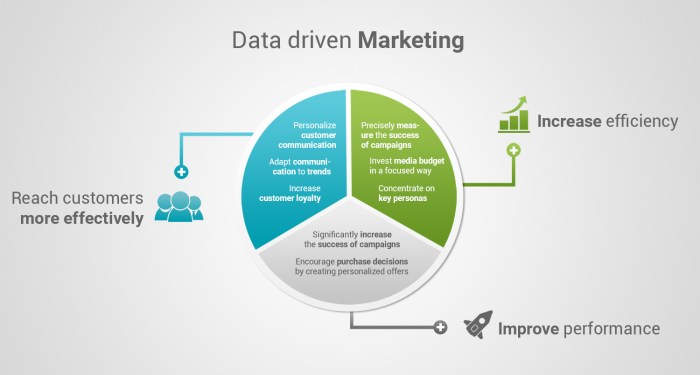Using Data to Drive Marketing sets the stage for a dynamic exploration of how businesses can leverage data to revolutionize their marketing strategies, captivating audiences with personalized campaigns and innovative decision-making processes. Dive into the realm of data-driven marketing and discover the power it holds in transforming the industry landscape.
Importance of Data in Marketing
In the fast-paced world of modern marketing, data plays a crucial role in driving strategies and decision-making processes. By leveraging data analytics, marketers can gain valuable insights into consumer behavior, preferences, and trends, allowing them to create more targeted and personalized campaigns.
Enhancing Customer Engagement
- Data-driven marketing enables companies to better understand their customers by analyzing their online interactions, purchase history, and demographic information.
- By utilizing this data, marketers can create tailored content and offers that resonate with their target audience, leading to higher engagement rates and increased brand loyalty.
- For example, e-commerce platforms use customer data to recommend products based on past purchases, browsing behavior, and feedback, resulting in a more personalized shopping experience.
Personalizing Marketing Campaigns
- Data allows marketers to segment their audience into specific groups based on factors such as age, location, interests, and buying habits.
- With this information, companies can deliver customized messages and promotions to each segment, increasing the likelihood of conversion and retention.
- Personalization in marketing has been shown to boost customer satisfaction, drive sales, and foster long-term relationships with consumers.
Types of Data Used in Marketing

In the world of marketing, data plays a crucial role in understanding consumer behavior, targeting the right audience, and measuring the effectiveness of campaigns. Let’s explore the different types of data commonly utilized in marketing efforts.
First-party Data
First-party data is information collected directly from your audience or customers. This includes data from website analytics, social media interactions, email subscriptions, and purchase history. This data is considered the most reliable and valuable as it comes straight from the source.
Second-party Data
Second-party data is essentially another company’s first-party data that is shared with you through a partnership or collaboration. This type of data can provide additional insights into a specific audience segment or help expand your reach to new potential customers.
Third-party Data
Third-party data is information purchased from external sources that can supplement your existing data. This data is often aggregated from various channels and can include demographic information, behavioral patterns, and interests of a broader audience. While this data can be beneficial for targeting new prospects, it may not always be as accurate or specific as first-party data.
Significance of Leveraging Big Data in Marketing Analytics
Big data refers to the vast amount of structured and unstructured data that companies can collect and analyze to gain insights and make informed decisions. In marketing, leveraging big data allows businesses to identify trends, predict consumer behavior, personalize messaging, and optimize campaigns for better results. By harnessing the power of big data analytics, marketers can create more targeted and impactful strategies that resonate with their audience.
Implementing Data-Driven Decision Making

Implementing data-driven decision making in marketing can greatly improve the effectiveness of campaigns and strategies. By integrating data into decision-making processes, companies can optimize their efforts and ensure they are targeting the right audience with the right message.
Integrating Data into Decision-Making Processes
- Collect Relevant Data: Start by collecting data that is relevant to your marketing goals. This can include customer demographics, purchasing behavior, website analytics, and more.
- Analyze Data: Use data analysis tools to analyze the information collected and identify patterns, trends, and insights that can inform your decision-making.
- Set Clear Objectives: Define clear objectives based on the data analysis findings to guide your marketing strategies and campaigns.
- Implement Changes: Use the insights gained from data analysis to make informed decisions and implement changes to your marketing initiatives.
Challenges in Interpreting Marketing Data
- Data Overload: With the abundance of data available, it can be overwhelming to sift through and extract meaningful insights.
- Data Quality: Ensuring the accuracy and reliability of the data being used is crucial to making informed decisions.
- Data Integration: Combining data from various sources and systems can be challenging and may lead to inconsistencies.
- Data Privacy: Maintaining data privacy and complying with regulations while utilizing data for decision-making is a constant challenge.
Examples of Successful Companies Utilizing Data-Driven Decision Making
- Amazon: Utilizes customer data to personalize recommendations and enhance the shopping experience, leading to increased sales and customer loyalty.
- Netflix: Analyzes viewer data to recommend personalized content, optimize streaming quality, and produce successful original series based on viewer preferences.
- Starbucks: Utilizes customer data from its loyalty program to customize promotions, product offerings, and store layouts, resulting in increased customer engagement and retention.
Data Collection Techniques in Marketing: Using Data To Drive Marketing
In the world of marketing, data collection techniques play a crucial role in understanding consumer behavior and preferences. By utilizing various methods to gather data, businesses can tailor their marketing strategies to target the right audience effectively.
Surveys and Questionnaires
Surveys and questionnaires are common tools used to collect consumer data in marketing. By asking targeted questions, businesses can gather valuable insights into customer preferences, buying habits, and feedback on products or services.
Social Media Monitoring
Social media platforms provide a wealth of data that can be used for marketing purposes. By monitoring social media channels, businesses can track consumer sentiment, trends, and interactions to inform their marketing strategies.
Website Analytics
Analyzing website traffic and user behavior through tools like Google Analytics can provide valuable data for marketing campaigns. Businesses can track user engagement, conversion rates, and popular content to optimize their online presence.
Purchase History and Customer Relationship Management (CRM) Data
Tracking customer purchase history and utilizing CRM systems can provide businesses with insights into individual customer preferences and behaviors. By analyzing this data, businesses can create personalized marketing campaigns tailored to specific customer segments.
Ethical Considerations
It is crucial for businesses to consider ethical considerations when collecting consumer data for marketing purposes. Respecting consumer privacy, obtaining consent for data collection, and ensuring data security are essential practices to maintain trust with customers.
Importance of Data Accuracy and Integrity, Using Data to Drive Marketing
Data accuracy and integrity are paramount in marketing campaigns to ensure that decisions are based on reliable information. Inaccurate data can lead to ineffective strategies and wasted resources, highlighting the importance of maintaining data quality in all marketing efforts.





